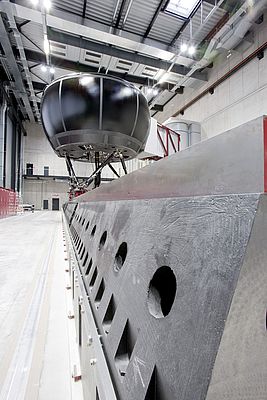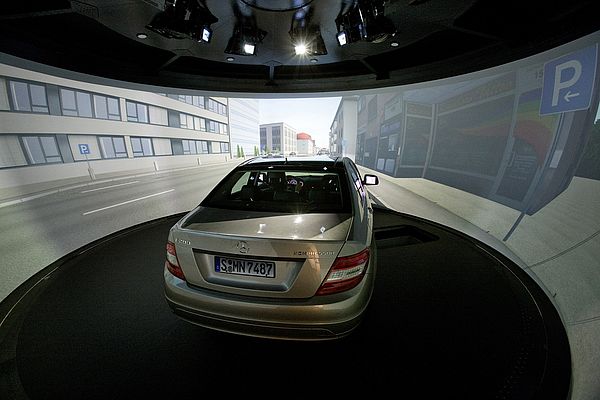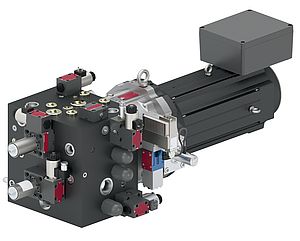A dynamic driving simulator, based on the latest high-dynamic motion system, a twelve long linear rail, and Daimler’s systems integration, heightens assessment reality
Daimler’s driving simulator center in Sindelfingen, Germany, contains different types of simulators all optimized for specific test situations including research, assessment and training. This center includes both fixed base driving simulators and a ride and comfort simulator previously delivered by Moog. Being part of the Mercedes-Benz Technology Center, the driving simulator center is an integral part of research and development activities.
The electrical motion base is a hexapod consisting of six moveable supporting legs. It has six degrees of freedom (DOF): The top platform moves in x, y and z directions, and rotates over all three axes (pitch, roll and yaw). The entire motion system is mounted on the lateral rail, which makes possible the simulation of sideways movements such as lane changes that a hexapod on its own cannot simulate because of stroke limitations of the actuators. The motion system is driven along the rail using linear motors.
Inside the dome there is a full Mercedes-Benz car model where test drivers seat and view a 360° projection screen showing real-life traffic scenes, with moving pedestrians, oncoming traffic and buildings.
The complete motion system of the hexapod and lateral rail is controlled by real-time software. From the driver’s input to the pedals and steering wheel, the Daimler vehicle models calculate position, velocity and acceleration data. The software translates this information to movements in the hexapod and lateral rail to ensure the driver’s sensory expectations are matched. Consequently, driving the simulator feels just like driving a normal car. Everything that the driver sees projected onto the dome is matched by what he or she feels through the movement of the car generated by the hexapod and rail. So when the driver presses the accelerator, brakes, turns the steering wheel or drives over a virtual bump, the combination of the changing image, together with the movements of the motion system, provide the sensation that the car is moving along a real road.
With its high speed electric motion system on a twelve-meter long rail for transverse movements and 360° screen, the dynamic simulator is the most advanced in the automobile industry. The system as integrated by Daimler engineers also features leading-edge energy efficient technology. Part of the energy required to drive the simulator is obtained by means of energy recuperation when braking and fed into the power network of the Sindelfingen plant.
“Meeting the challenge of our customers with innovative motion control and test solutions is the key to their worldwide success. For the last decade, simulators have been applied in many areas including research, assessment and training. The development of Daimler’s latest dynamic driving simulator was very challenging in terms of the technologies required to meet their specifications. We were one of the committed partners to the project and we were able to bring new ideas and approaches to satisfy the technical requirements and meet the project specifications and objectives” said Pim van den Dijssel, business manager Europe, for Moog.
Whereas the previous Daimler simulator with hydraulic actuators generated sufficiently realistic drive feel, the new high dynamic electrical motion system is especially designed for both high performance and realistic drive assessment with expert drivers.
The motion system is mounted on a 12 meter long axis for large-scale linear motion. Additionally, a quasi static 90 degrees turn table inside the dome allows use of the lateral rail for both lateral (drive dynamic experiments) and longitudinal (stop and go traffic simulation) motions.
Moog’s design for the electric actuators outperforms expectations for responsiveness and together with the Moog control cabinets uses less energy, runs more quietly, and is easier to maintain. The latest dynamic driving simulator can induce an improved longitudinal motion sensation for all possible acceleration and deceleration scenarios.
Pim van den Dijssel, added: “Daimler had also considered mounting the entire system on a longitudinal rail to provide an eighth DOF, but decided that the extra cost did not justify the benefit. The motion base we developed meets Daimler’s requirements using our latest design developments. Braking and acceleration can be simulated extremely well by tilting the hexapod backwards and forwards. If necessary, the vehicle can be turned through 90 degrees, so that the lateral rail in fact becomes a longitudinal rail. This allows abrupt lane changes and strong braking manoeuvres to be simulated with more than 1 g of acceleration.”
“We worked closely with Daimler’s engineering team to develop this system, and this challenging project required a completely new and very different approach. We are delighted to hear positive feedback from engineers working with the system,” said van den Dijssel

























